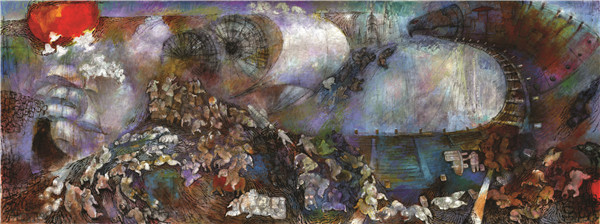The magic of myth
 |
|
The Ark by Yang Yang, Acrylic on paper. [Jian Ping for China Daily] |
When it comes to abstract art, meaning, like beauty, can all be in the eye of the beholder.
A solo show of the works of celebrated Chinese artist Yang Yang opened at the ArtSpace 8 gallery in Chicago in September and will run until Nov 6, with 21 of his paintings filling one of the gallery's two floors.
Many of the works in the show entitled "Beyond Dimension" are large and striking, covering entire walls and best viewed from a distance.
Yang Yang, 64, chatted with patrons at a reception held before the exhibition's opening to the public.
"Yang Yang's paintings have many Chinese elements," said Fidel Rodriguez, owner of the gallery and an artist in his own right. "He is using the Western language to tell Chinese stories."
All of the paintings on display are abstract, with many invoking mythical themes where animals and humans share their existence. Most of the images are presented in monochromatic or brilliant colors, sometimes with a combination of the two. There is a touch of red in most of them, a color one patron called "Yang's unique Chinese red."
The Chinese elements in Yang's paintings include calligraphy, Chinese ink painting and mythology.
"I grew up in China," said Yang. "Chinese culture has a great influence on me."
 |
|
Yang Yang posing in front of his painting, The 3rd Magaton, in acrylic on paper. [Jian Ping for China Daily] |
Yang said he received training in realistic and traditional painting styles in China. It was only after he came to the US to study art in 1984 that he began to explore the abstract style.
"I had a couple of professors at Augustana College (Sioux Falls, South Dakota) who were very much into American impressionism," said Yang, recalling his transformation from realistic painting to abstract. "They showed me the multi-dimensions that abstract paintings could have."
Yang awakened to the new art form and fell in love with its freedom and possibilities.
"If you paint a nurse or a worker realistically, a viewer sees what it is," Yang said. "But an abstract image can tell so many different stories."
Yang said he is very much enchanted by Chinese mythology and always tries to tell a story in his work.
A recurring image in Yang's paintings is groups of crawling humans, on land or water. Their ambiguous figures are free of race, skin color or ethnicity.
"Yang Yang has cultivated a style that deftly synthesizes traditions from both his Chinese heritage and his Western education, lending a cultural and temporal ambiguity to his work," observed Qiwei Liu, curator at Shandong Fine Art Museum where Yang had a solo exhibition and where some of his paintings were purchased for the permanent collection.
Yang said that to him, a work of art should express itself.
"It's not important what an artist's original intention is," he said, adding that he would rather his viewers tell him the stories they are reading in his work, and he hopes they're different from his.
Donna Bliss, a patron at the reception, seemed to illustrate Yang's point.
 |
|
Ride Riders by Yang Yang, Mixed media on canvas. |
Standing in front of a painting titled Red Riders, Bliss appeared deep in thought.
"To me, Red Riders looks like the world is riding together," she said. "I really feel if we all work in harmony, we could go a long way. That's what this piece means to me."
John Robinson, publisher of Mandarin Leaders which co-organized the reception, gave a modern spin on another piece titled The Ark, with stories of commerce, competition and survival of the fittest, which couldn't have been further from the story of Noah's Ark.
Yang stood by listening with a smile.
"I want my viewers to get beyond the limits of the canvas and fly away with their own imagination," he said.
Yang's artworks have been shown and collected by the Minneapolis Institute of Arts, the Museum of Fine Art, Shaanxi and the Mobile (Alabama) Museum of Art.
Yang has had numerous solo exhibitions over the years, including at the Kansas City Art Center, Kansas City, the Art Asia Basel, Hong Kong and the Chinese American Arts Council in New York.
Yang said he often works on multiple pieces simultaneously, with one as the primary work.
"I used to do sketches before painting, not anymore," he said. "I see visions on my canvas and I try to capture them. I don't know what a piece would look like until I finish it."









